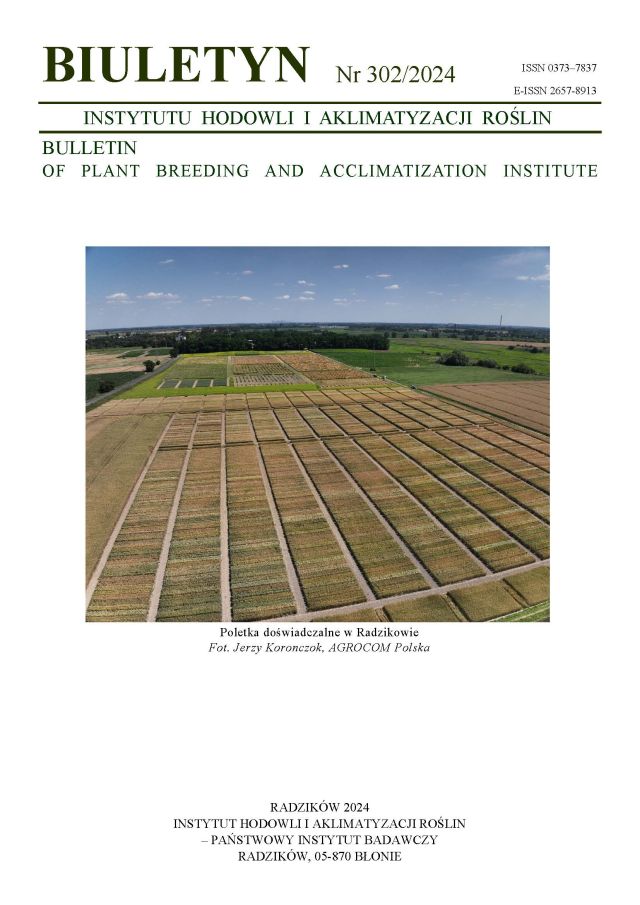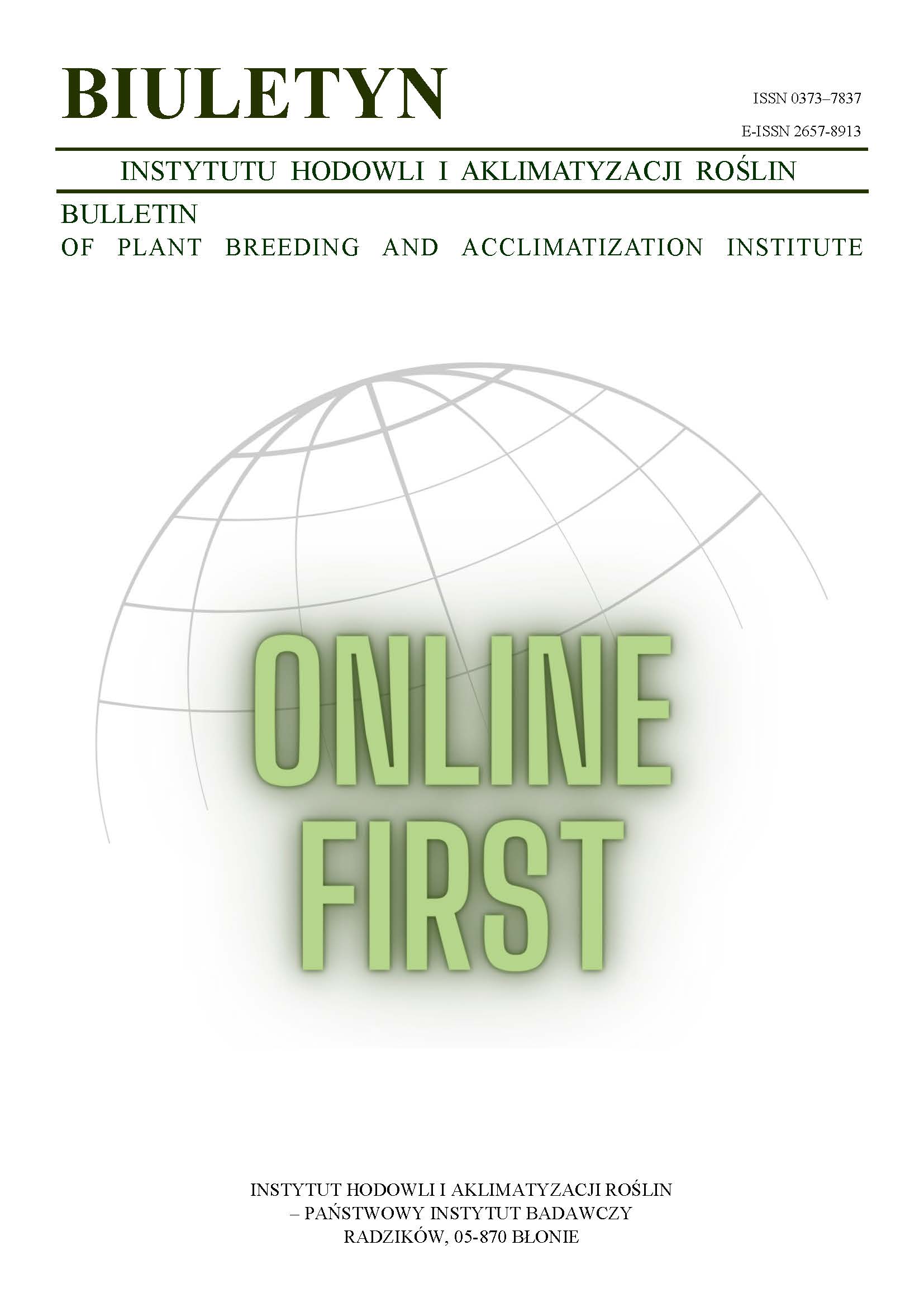Combining ability of cms lines, strains and cultivars of triticale for susceptibility to seedling blight caused by Fusarium culmorum
Tomasz Warzecha
kfhrin@urk.edu.plKatedra Hodowli Roślin i Nasiennictwa, Akademia Rolnicza w Krakowie (Poland)
Halina Góral
Katedra Hodowli Roślin i Nasiennictwa, Akademia Rolnicza w Krakowie (Poland)
Abstract
The following triticale genotypes were examined for susceptibility to fusarium seedling blight: 4 male sterile lines, 5 male fertile genotypes and 20 F1 hybrids received from crosses between parental genotypes in factorial design. Grains of triticale were inoculated with isolate IPO 348-01 originated from Institute of Plant Protection, Wageningen. Single isolates of Fusarium culmorum were cultivated on the PDA medium (Potato Dextrose Agar-Sigma) on Petri dishes. The inoculated grains were incubated for 7 days at 22°C. The hybrids showed average lower leaf infection score and similar root infection score in relation to the parents. Significant correlation coefficient between leaf infection score of hybrids and GCA of parents was proved, it gives opportunity to select parental components towards higher resistance on the GCA base. Seedling infection was more dependant on SCA of parental couples then on GCA of the parents. Correlation coefficients between leaf and root infection of hybrids and SCA effects of parental couples were positive and significant (respectively r=0,642** and 0,881**). The received results indicated out that resistance level of hybrids to F. culmorum was also dependant on nonadditive gene effects and prediction based only on GCA of parents could be not reliable enough.
Keywords:
Fusarium culmorum, GCA, SCA, triticaleReferences
Cauderon Y., Cauderon A., Gay G., Roussel J. 1985. Alloplasmic lines and nucleo-cytoplasmic interactions in triticale. In: Proc. Eucarpia meet. „Genetics and breeding of Triticale”. Clermont-Ferrand, France, INRA, Paris, 2–5 July 1984: 177 — 191.
Google Scholar
Grey W. E., Mathre D. E. 1988. Evaluation of spring barleys for reaction to Fusarium culmorum seedling blight and root rot. Can. J. Plant Sci. 68: 23 — 30.
DOI: https://doi.org/10.4141/cjps88-002
Google Scholar
Nalepa S. 1990. Hybrid triticale: present and future. In: Proc. 2nd Int. Triticale Symp., Passo Fundo, Rio Grande do Sul, Brazil, 1–5 October 1990: 402 — 407.
Google Scholar
Oettler G., Heinrich N., Miedaner T. 2004. Estamates of additive and dominance effects for Fusarium head blight resistance of winter triticale. Plant Breeding 123 (6): 525 — 530.
DOI: https://doi.org/10.1111/j.1439-0523.2004.01010.x
Google Scholar
Spiss L., Góral H. 1994. Hodowla form męskosterylnych i przywracających płodność u pszenżyta. Zesz. Nauk. AR w Szczecinie, 162, ser. Rolnictwo 58: 243 — 246.
Google Scholar
Ubysz-Borucka L., Mądry W., Muszyński S. 1985. Podstawy statystyczne genetyki cech ilościowych. SGGW-AR, Warszawa.
Google Scholar
Warzecha T., Góral H. 2005. Podatność auto- i alloplazmatycznych linii pszenżyta na zgorzel siewek wywołaną przez Fusarium culmorum (W.G.Sm.) Sacc. Biul. IHAR 236: 109 — 113.
Google Scholar
Warzecha R., Salak-Warzecha K. 2002. Hybrid triticale — prospects for research and breeding — Part II: Development of male sterile lines. In: Proc. 5th Int. Triticale Symp., IHAR Radzików, Poland, 30 June — 5 July 2002, vol. I: 193 — 198.
Google Scholar
Wiśniewska H., Kowalczyk K. 2005. Resistance of cultivars and breeding lines of spring wheat to Fusarium culmorum and powdery mildew. J. Appl. Genet. 46 (1): 35 — 40.
Google Scholar
Wiśniewska H., Chełkowski J. 1997 b. Comparison of barley cultivars tolerance to frost and seedling blight. J. Appl. Genet. 38 B: 134 — 140.
Google Scholar
Woś H., Góral H., Woś B., Spiss L. 2002. Heterosis in winter triticale with T. timopheevi cytoplasm. In: Proc. 5th Int. Triticale Symp., IHAR Radzików, Poland, 30 June — 5 July 2002, vol. II: 311 — 315.
Google Scholar
Authors
Tomasz Warzechakfhrin@urk.edu.pl
Katedra Hodowli Roślin i Nasiennictwa, Akademia Rolnicza w Krakowie Poland
Authors
Halina GóralKatedra Hodowli Roślin i Nasiennictwa, Akademia Rolnicza w Krakowie Poland
Statistics
Abstract views: 92PDF downloads: 23
License
Copyright (c) 2006 Tomasz Warzecha, Halina Góral

This work is licensed under a Creative Commons Attribution-ShareAlike 4.0 International License.
Upon submitting the article, the Authors grant the Publisher a non-exclusive and free license to use the article for an indefinite period of time throughout the world in the following fields of use:
- Production and reproduction of copies of the article using a specific technique, including printing and digital technology.
- Placing on the market, lending or renting the original or copies of the article.
- Public performance, exhibition, display, reproduction, broadcasting and re-broadcasting, as well as making the article publicly available in such a way that everyone can access it at a place and time of their choice.
- Including the article in a collective work.
- Uploading an article in electronic form to electronic platforms or otherwise introducing an article in electronic form to the Internet or other network.
- Dissemination of the article in electronic form on the Internet or other network, in collective work as well as independently.
- Making the article available in an electronic version in such a way that everyone can access it at a place and time of their choice, in particular via the Internet.
Authors by sending a request for publication:
- They consent to the publication of the article in the journal,
- They agree to give the publication a DOI (Digital Object Identifier),
- They undertake to comply with the publishing house's code of ethics in accordance with the guidelines of the Committee on Publication Ethics (COPE), (http://ihar.edu.pl/biblioteka_i_wydawnictwa.php),
- They consent to the articles being made available in electronic form under the CC BY-SA 4.0 license, in open access,
- They agree to send article metadata to commercial and non-commercial journal indexing databases.
Most read articles by the same author(s)
- Stefan Stojałowski , Marta Orłowska , Martyna Sobczyk , Anna Bienias , Marcin Berdzik , Beata Myśków , Halina Góral , Magdalena Simlat , Tomasz Warzecha , Wojciech Wesołowski , Marek Szklarczyk , Mirosław Pojmaj , Genetic background of male sterility in triticale with different cytoplasm’s and perspectives of it utilization for development of CMS system in wheat , Bulletin of Plant Breeding and Acclimatization Institute: No. 286 (2019): Special issue
- Halina Góral, Male fertility of winter triticale depending on the cytoplasm and male parent , Bulletin of Plant Breeding and Acclimatization Institute: No. 269 (2013): Regular issue
- Halina Góral, Maciej Ejsmond, Combining ability analysis and heritability of yield components in linseed (Linum usitatissimum L.) , Bulletin of Plant Breeding and Acclimatization Institute: No. 249 (2008): Regular issue
- Halina Góral, Mirosław Pojmaj, Renata Pojmaj, Monika Burczy, Production of hybrid seeds of winter triticale from cms and restoring lines in strip and bulk sowing , Bulletin of Plant Breeding and Acclimatization Institute: No. 252 (2009): Regular issue
- Zygmunt Kaczmarek, Tomasz Warzecha, Tadeusz Adamski, Maria Surma, Multivariate approach to estimation of reduction of yield components in hulless and hulled DH lines of barley inoculated with Fusarium culmorum , Bulletin of Plant Breeding and Acclimatization Institute: No. 226/227 (2003): Regular issue
- Tomasz Warzecha, Tadeusz Adamski, Zygmunt Kaczmarek, Maria Surma, Gene effects on susceptibility of naked and hulled barley doubled haploids to Fusarium culmorum head blight , Bulletin of Plant Breeding and Acclimatization Institute: No. 226/227 (2003): Regular issue
- Halina Góral, Mirosław Pojmaj, Renata Pojmaj, Frequency of maintainer and restorer genotypes for the cms-T. timopheevi system winter triticale , Bulletin of Plant Breeding and Acclimatization Institute: No. 244 (2007): Regular issue
- Elżbieta Pisulewska, Julita Maciejewicz-Ryś, Halina Góral, Yield, chemical composition and protein quality in long flower head forms of red clover (Trifolium pratense L.) , Bulletin of Plant Breeding and Acclimatization Institute: No. 228 (2003): Regular issue
- Tomasz Warzecha, Halina Góral, Susceptibility of auto- and alloplasmic triticale lines to seedling blight caused by Fusarium culmorum (W.G.Sm.) Sacc. , Bulletin of Plant Breeding and Acclimatization Institute: No. 236 (2005): Regular issue
- Halina Góral, Jadwiga Przypadek, Ludwik Spiss, Selection of red clover (Trifolium pratense L.) with regard to length and number of flower heads , Bulletin of Plant Breeding and Acclimatization Institute: No. 226/227 (2003): Regular issue














